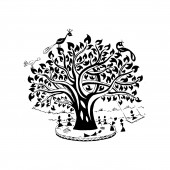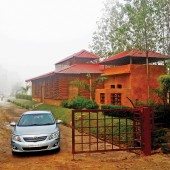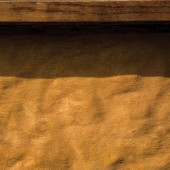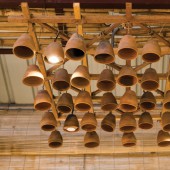DESIGN NAME:
Enroot
PRIMARY FUNCTION:
Restaurant
INSPIRATION:
The building is located in a rural setting, the design borrows from the rural landscape and local arts and crafts of the region. The unevenness and rawness of hand work is reflected in all the components.
UNIQUE PROPERTIES / PROJECT DESCRIPTION:
Sitting amidst sprawling green surroundings and celebrating the grains, textures and unevenness inherent of its constituent materials, the space captures the spirit of the rural landscape. The exterior walls are hand plastered with integrally earthy-coloured cement. Horizontal scrapwood louvers run around the building lending it a Zen-like character. The interiors have handcrafted elements developed with the local Potters and Rope weavers while a Warli style painting summarises the entire theme
OPERATION / FLOW / INTERACTION:
-
PROJECT DURATION AND LOCATION:
The project started in January 2015 at Village Azadpur Mafi near Gajraula Uttar Pradesh, India. The site is situated on the National Highway no 24. It was completed in February 2016
FITS BEST INTO CATEGORY:
Architecture, Building and Structure Design
|
PRODUCTION / REALIZATION TECHNOLOGY:
The external walls were finished with coloured cement plaster. The intrinsic colour was achieved by adding a specific ratio of red and yellow iron oxides to the cement mix. Its application was intentionally done by hand, alluding to mud plastered walls in the villages. The facade louvers were made out from scrap-wood and suspended with a system of ropes and wire. Local pottery craft was used to create planters fashioned like earthen pots, which were then fixed in an MS frame in an opening in the wall. The internal ceiling was kept exposed and elements and lighting fixtures were suspended from an MS frame. Ropes which are a product of a local cottage industry, were used extensively in various elements.
SPECIFICATIONS / TECHNICAL PROPERTIES:
1,500 square feet of built up area
TAGS:
Green, Sustainable, Local, Art, craft
RESEARCH ABSTRACT:
The key research points were appropriate technology and relevant arts and crafts.
The coloured cement plaster was developed through a trial and error method, and different samples were created with the help of the mason before finalising.
The furniture and facade were created out of scrap wood, after consultations with local craftspersons and carrpenters.
The local crafts had to be found and captured by travelling to the nearby villages.
CHALLENGE:
The challenge was to create a truly local experience from local resources, labour and art. The site was remote and labour was untrained, which required extensive supervision. Designs of elements were developed through a dialogue between the architect and the crafts-persons, and thus required several visits and working with the hands.
ADDED DATE:
2017-02-27 10:58:33
TEAM MEMBERS (2) :
Arnav Mathur and Siddharth Bansal
IMAGE CREDITS:
Rohan Dayal, Arnav Mathur
|










